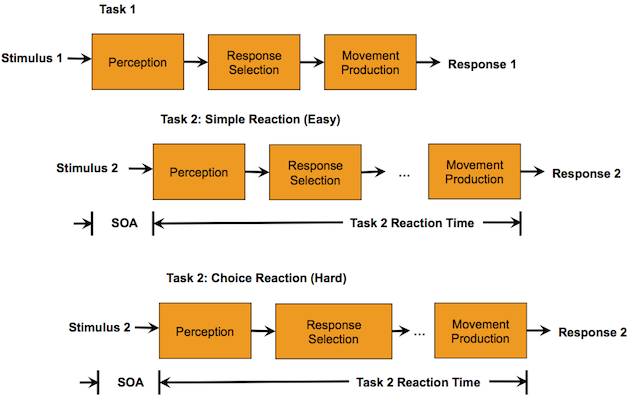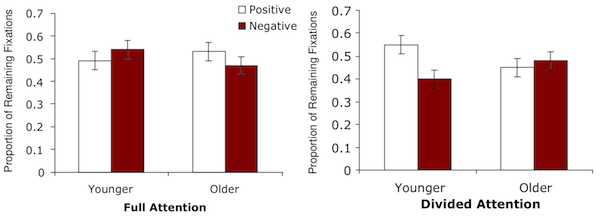Although much of our work explores what we can learn from contexts in which participants are unable to apply strategies due to various cognitive constraints, in some cases people are less constrained than believed. For example, under some circumstances, people can perform multiple tasks at once; a navy pilot can fly an aircraft, operate a radar, and manage tactical goals simultaneously. In other situations, multi-tasking appears problematic, for example driving while talking on a phone can lead to significant impairment even for experts. Researchers have asked whether the brain is inherently parallel and can coordinate multiple simultaneous processes, or whether there are structural bottlenecks making any apparent parallelism an illusion. One theory suggests that there is a central cognitive bottleneck such that when multiple stimuli in the world need to be responded to, they must be processed serially. Evidence for this comes from the Psychological Refractory Period (PRP) task where participants are asked to respond to two stimuli separated by 50-1000 milliseconds. Data show that when Stimulus2 is presented long after Stimulus1, Stimulus2 responses are fast. However, when the Stimulus2 arrives only 50 milliseconds after Stimulus1, its response is considerably slowed (called the “PRP effect”). Presumably, by 1 second participants have finished perceiving and responding to Stimulus1, and can thus respond to Stimulus2 right away. But with the small delay, Stimulus2 arrives while the participant is busy, forcing Response2 to wait (viz, Pashler 1994). Our view is that that the brain is inherently parallel and lacks central cognitive bottlenecks. Thus, with practice, humans can flexibly allocate cognitive resources and employ a variety of cognitive strategies. In some instances we use daring strategies that overlap the processing of multiple stimuli. At other times, we employ more cautious strategies that involve processing one stimulus at a time. In this work, we and our colleagues have show that PRP effects results from cautious strategies and not cognitive bottlenecks.

In one study, we found evidence against the bottleneck hypothesis and in support of flexible cognitive control. We showed that with practice, participants could overlap Task1 and Task2 processing, even when both task stimuli were presented simultaneously (0 ms delay)! We also showed that one factor influencing whether participants choose cautious or daring strategies in this task was the instructions given to them. In the typical PRP task, participants are encouraged to produce the Task1 response before the Task2 response, which encourages them to adopt a serial strategy and produce data consistent with a bottleneck. In this research, we had participants perform over the course of six days in a task where they were encouraged to produce both responses as quickly as possible. With these instructions, participants’ data show no evidence of a bottleneck and they were not only able to process two stimuli and produce two responses at once, but their performance on each task was identical to when only one task had to be performed in isolation. On the seventh day, we asked these same participants to perform under the standard PRP instructions, and observed the typical PRP effect. Thus, we concluded that humans are flexible in choosing cautious or daring strategies, but may be affected in this choice by task constraints such as the instructions or reward schedule (Schumacher, Seymour, Glass, Kieras, & Meyer, 2001).

In another study we tested our hypothesis that PRP effects result from cautious strategies by comparing participants known to prefer daring task strategies to those known to prefer more cautious ones. In particular we compared young adults, who tend to do quite well on speeded cognitive tasks, to older adults, who have particular trouble with multiple-task performance. In a PRP task, all participants produced the standard effect, however older adults were slower overall and produced a larger PRP effect (showed greater Task2 slowing when the Task1-Task2 delay was short) than younger adults. Because numerous studies have reported general cognitive slowing with age (e.g., Somberg & Salthouse 1982), this finding may be the result of general slowing of a system with a central bottleneck, rather than a cautious strategy in a system with no bottleneck. To test this, we tested two sets of computational models; one set where differences between old and young participants were modeled as differences in overall processing speed; and one set where both processing speed and strategy type were modeled. The results showed that generalized slowing alone was not sufficient to account for the performance of older adults, and their data could only be successfully modeled when they were assumed to be slower and using a more cautious strategy compared to younger adults (Glass, Seymour, Schumacher, Gmeindl, Meyer, & Kieras, 1998). In other research, we showed that in some cases older adults were not slower than young participants after all, and that differences in performance could be completely accounted for by differences in strategy. Indeed, some daring older adults show no differences at all compared to younger adults. This research suggests that general slowing explanations may be overused when describing older adults’ performance (Meyer, Glass, Mueller, Seymour, & Kieras, 2001).


In a more recent study, we have continued my interest in understanding cognitive constraints and strategy by comparing participants of different age ranges. In the dot-probe task, two small photographs (faces: one emotional and one neutral) are presented on either side of a computer monitor and then disappear revealing a dot behind one or the other. Participants are simply asked to quickly press a left or right button depending on where the dot is. Although they are irrelevant, the photographs can influence response time to the dots. An influential study by Mather & Carstensen (2003) showed that in this task, older adults responded faster to the dot if it was presented on the same side as a neutral face than if it was presented on the same side as a negative face. Younger adults exhibited no such “attentional bias”. We wondered if, like cognitive slowing, this bias was more strategic than suggested in this work. The results of an eye-tracking study designed to answer this question suggest that although in a single-task condition older adults show the bias against negative faces, in a dual-task condition featuring a constantly distracting tone task, this effect reversed! This result confirms that the attentional bias is due to a cognitive strategy that requires sufficient attention to maintain, rather than a structural change associated with aging (Knight, Seymour, Gaunt, Baker, & Mather, 2007).